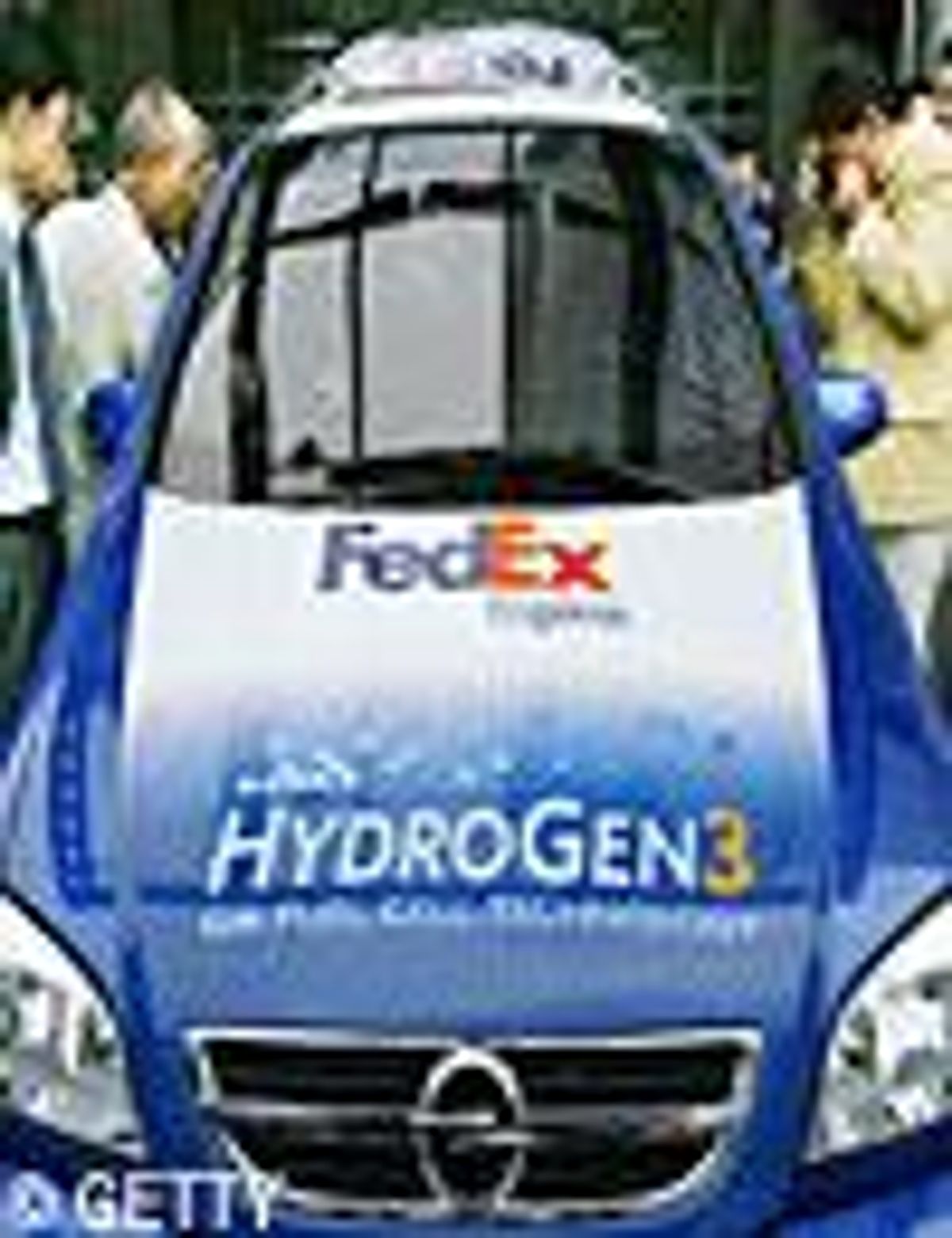All Rights reserved
By continuing to use our site, you agree to our Private Policy and Terms of Use.
Like many environmentally minded people, I thought I knew something about high-mileage, alternative-fuel vehicles. For instance, I'm aware that the Prius gets 55 miles per gallon (at least four times more than the Hummer). I realize the Honda Accord Hybrid emits half as many tons of greenhouse gas per year as a VW Touareg. It goes without saying that driving one of these babies makes me look evolved, and it means I can go solo in the carpool lane in 10 states, including California.
But when I sat down for a cup of coffee with Dave Barthmuss, manager of environment and energy communications at General Motors, I learned that alternative fuel is more complicated than just closing the lid on the OPEC cookie jar. There's affordability, safety, and practicality to consider. Can your mechanic fix a $92,000 battery-powered Tesla Roadster? Do you want him to?
School children gaze at an engine of GM's fuel cell vehicle HydroGen3 at a Tokyo elementary school.
While the search for a magic carpet ride continues, GM has drawn up a multipronged approach to alternative fuel, said Barthmuss at a recent "LGBT drive" in Laguna Beach, Calif. It looks something like this:
(1) Use hybrid technology in more GM models like the Saturn VUE and the Chevy Tahoe. (Barthmuss swears there's a demand for eco-friendly who's-your-daddy rides.)
(2) Make more GM models "flex-fuel"--i.e., able to run on either regular gas or 85% ethanol, known as E85. For the record, Hummer says it will make all of its models capable of running on alternative fuel by 2009.
(3) Apply advanced science to engines (for instance, eight cylinders that run on four until the driver needs more power) so that they achieve higher mileage.
(4) Avoid ceding the title of number 1 automaker to Toyota.
OK, Barthmuss didn't actually say that last one. But it's likely a large part of what this is all about. In 2004, GM vice chairman Bob Lutz called hybrids "an interesting curiosity." That was one year before Toyota's sales rose 10% and GM's fell 4.3%.
Enter the HydroGen3, an 18-vehicle fleet of hydrogen-fueled cars that GM is testing in a limited capacity. Prototypes of the HydroGen3 are used to deliver the mail in Orange, Calif., and Washington, D.C.; others are battling the elements throughout Europe and Asia. The glitches and quirks they uncover will benefit future generations of Chevys. Beginning this year GM's Project Driveway will gather information about consumer needs and vehicle performance from a team of GM daily-duty drivers.
It's all part of a fact-finding mission aimed at getting fuel cell cars on the road by 2010. In the meantime, the learning curve is not without accolades earned: The HydroGen3 is the first fuel cell vehicle to be certified by the Japanese government for operation on regular roads.
General Motors may have dragged its feet on the way to alternative fuel, but I can forgive that. For years GM has reached out to the LGBT community like no other carmaker. It organized LGBT-specific test drives; it also created GM PLUS, a LGBT affinity group that answers questions and concerns from GM's gay and lesbian employees. At this year's North American International Auto Show in Detroit, its GM Diversity program hosted LGBT guests.
It was that kind of outreach that brought me to the LGBT drive and put me behind the wheel of a $1 million automobile. Tim Perzanowski, a vehicle system engineer in Torrance, Calif., explained how the engine worked. In a nutshell, a fuel cell engine uses hydrogen that's stored onboard the car, mixed with oxygen from the ambient air. Currently there is no stored power; the engine uses what it produces. It generates electricity, water, and heat, and not a single emission. Perzanowski says the next generation will include a battery pack to make stored power available instantly.
This will be a nice modification because, as is, the HydroGen3 needs time to get going. That's not to say it isn't an enjoyable driving experience. There's a lot to be said for being in command of a million-dollar ride. The HydroGen3 isn't sexy (it looks remarkably similar to a minivan), but it feels practical and smart. It can go 168 miles (249 in a liquid-hydrogen format) before needing a pit stop at a compressed-hydrogen fuel station. The inside is outfitted in black with decorative blue panels in the seats. An LCD display indicates the hydrogen system's activity. There's no stick shift (or traditional transmission); the hydrogen fuel cell sends the electricity directly to the drive motors to propel the car. Pressing one button moves the car forward, another puts it in reverse, and another functions as the parking brake. It's a little like driving an automatic cappuccino machine.
Safety is important to hydrogen fuel cell cars, as the hydrogen tank is under 10,000 psi of pressure. What would happen if we were in a collision? Perzanowski says that a special tank had to be engineered to sustain normal pressure and fit inside the vehicle--it's been tested rigorously to withstand temperature extremes and impact. Another safety feature automatically sets the brakes when the vehicle stops, which keeps the car from rolling on a incline. This takes a little getting used to. Pressing the accelerator when the traffic light turns green doesn't immediately release the brake, and when it does release, you're instantly moving forward.
In the end, it's not just a question of fuel. How affordable and available alternative-fuel cars become depends on purchasing habits, marketability, and consumer demand. But GM is banking on a greener future.
Want more breaking equality news & trending entertainment stories?
Check out our NEW 24/7 streaming service: the Advocate Channel!
Download the Advocate Channel App for your mobile phone and your favorite streaming device!
From our Sponsors
Most Popular
Here Are Our 2024 Election Predictions. Will They Come True?
Meet all 37 of the queer women in this season's WNBA
17 Celebs Who Are Out & Proud of Their Trans & Nonbinary Kids
Here Are the 15 Most LGBTQ-Friendly Cities in the U.S.
Which State Is the Queerest? These Are the States With the Most LGBTQ+ People
These 27 Senate Hearing Room Gay Sex Jokes Are Truly Exquisite
10 Cheeky and Homoerotic Photos From Bob Mizer's Nude Films
42 Flaming Hot Photos From 2024's Australian Firefighters Calendar
These Are the 5 States With the Smallest Percentage of LGBTQ+ People
Here are the 15 gayest travel destinations in the world: report
Trending stories from our video partner Advocate Channel.
For more videos and shows go to advocatechannel.com.



















































































